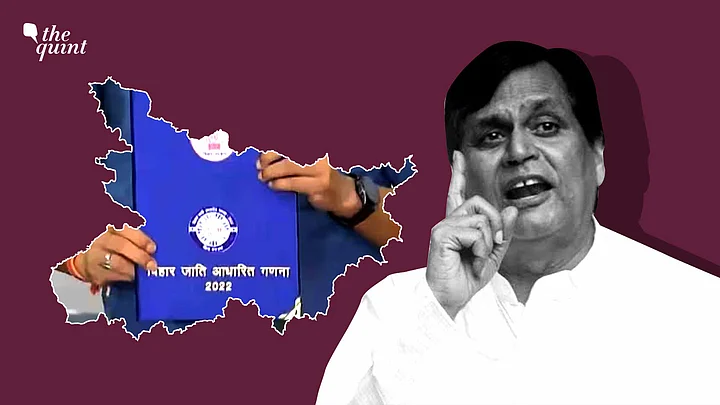Over 90 years after the first caste census was carried out by British in 1931, Bihar released the much-awaited caste survey which not only makes it clear that the OBCs and EBCs comprise 63% of the population but it also gives the proportions of Muslim castes and sub-castes in the state.
In 1931, Muslims comprised 14.6% of the state's total population. The share of Muslims have gone up by just 3% in over nearly a century, now standing at 17.7% of the state's total population of 13 crore.
The Quint spoke with Ali Anwar Ansari, Founder and National President of 'Pasmanda Muslim Mahaz' and a former MP of Rajya Sabha who had served for two terms. His fight to bring about a caste census to reveal realities of underprivileged Muslims is over a decade old.
He had first raised the cause as a special mention on 18 December 2009 in Parliament. However, he claims no one supported him then. With the support of Mulayam Singh Yadav, Lalu Prasad and BJP’s Gopinath Munde, it was raised in Lok Sabha in 2010 but it never materialised.
Now that the Bihar's caste survey is out, what does it mean for Muslims?
Would Bihar's caste survey create a churn in the Muslim community as caste-based data has been given within Muslims as well?
Yes, it will create a huge impact hopefully. It is the first caste-based survey since 1931 in which we have got a clear picture of Muslims and OBCs in a state. Till now, the common misconception has always been that Muslims are a monolithic and homogeneous group, and through everything, whether it’s about survey, representation or population, there’s only been a 'Hindu vs Muslim' narrative.
It has to be seen with a socio-economic lens as well, now we have the social aspect with the Bihar caste survey, we need the economic one — how much land, property, assets people own. Then we will know the overall condition of all caste groups.
"Most important benefit is that caste census is the only way to diffuse communal polarisation. Our slogan has always been: Sampradaik Dhurvikaran ka yahi ilaaj, jati jangarana ke liye hojao tayyar," said Ansari.
Are there any myths or misconceptions that the Bihar caste survey has debunked?
Out of the 17.7% the population is of Muslims in the state, the survey has also revealed that the ‘raftaar’ or the rate at which Muslim population has been growing, barely around 0.8%. This, as compared to Hindus’ which has declined but overall the rate is stable and slow. This totally punctures the BJP’s often-peddled narrative that Muslim population is growing at a faster rate and will overtake Hindu population.
Even in the General category, there are of course, Syed, Pathan, Sheikhs in Muslims and Brahmins, Rajput and Kayastha, but the percentage of Sheikhs (3.82%) is higher than Brahmins (3.66%). Even the top most backward groups are those of Muslims.
Will Bihar's state survey finally spur the reservation and representation debate in the right direction?
Yes, it must because Muslims too, have never really gotten fair representation. MPs belonging to only one or two castes have been elected. Pasmandas as a whole community has not been acknowledged.
And Pasmanda means ‘those who were left behind,’ it includes downtrodden Muslims and Dalits. Pasmanda denotes class, not caste.
Rahul Gandhi recently remarked that “Out of 90 secretaries of the central government, only 3 are OBC, who handle only 5% of India's budget.” All Muslims who have been left behind, whether it’s in policy-making, government or the private sector must be given their due representation.
Does the Bihar’s state survey invariably also open the debate on the 50% ceiling for reservations?
The survey will lead to questioning the 50% ceiling of reservation as well as the 27% of reservation for OBC, EBC and Muslims were included in it but now we know of their proportions to the state population.
Each class will get its due, especially political representation, parties will also have to either include them in leadership or as office bearers. “Humaari naukri mein humaare aadmi badhenge.”
Moreover, only 3% of the Brahmins are everywhere, dominating all sectors, institutions, jobs, media, academia, etc.
The fight should be to consider caste and religion as a secondary thought. This survey is even “two steps ahead” of Mandal report as Mandal did not include EBCs.
PM Modi reacting to the survey said, '"They're trying to divide the country on caste-lines.” What do you have to say about that?
In the next Lok Sabha elections in 2024, we will see the effect of the Bihar’s caste survey. PM Modi won’t allow the survey, even though he claims to be OBC himself. His antagonism comes from the fear that the OBC votes he has got so far will disintegrate. Moreover, if he gets the caste census done, communal polarisation would have to become secondary.
